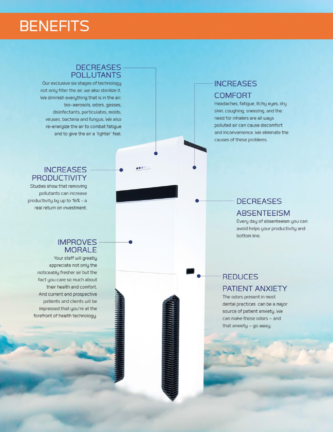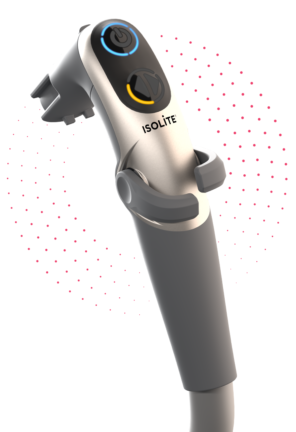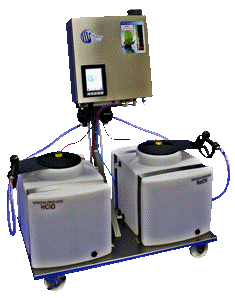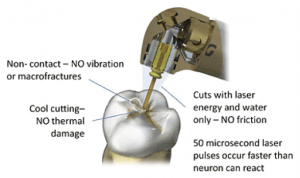HIGH TECH SAFETY in the “new normal”: our 3 main components to minimize germs
Dental offices are high traffic spaces: our regular, daily interactions with patients can introduce bacterial, viral, and fungal infections into the air. The indoor air within dental offices contains unhealthy and often infectious airborne pollutants, but we believe technology keeps our patients happier and healthier. Here are three major ways we use cleaning technology to ensure our patients and staff members are as protected as possible:

SURGICALLY CLEAN AIR FILTRATION: it doesn’t just filter germs, it destroys them.
Microbial air pollution is a real health issue and this is where technology makes us a better, healthier practice. Air purification systems can play a role in significantly reducing transmittable bio-aerosols Dental procedures inadvertently generate aerosols, containing organisms and debris from each patient’s oral activity, and these can be harmful to everyone present in the clinic. Air filters result in the significant reduction of viable particles in the air. World-class medical-grade air purifiers like our Surgically Clean Air system remove chemicals, toxins, germs, and odors, but most importantly, they kill airborne viruses, to help reduce the spread of illness.
By using a six-stage purification system of filters and UV lights, we ensure that the air you breathe is clean, healthy, and odor-free. Stages 1 and 2 remove large and microscopic air contaminates. Stage 3 absorbs unhealthy odors, chemicals, and gases. Stages 4 and 5 kill bacteria and viruses, while stage 6 re-energizes the clean air before circulating it back into the room.
We invested in Surgically Clean Air systems within our office because we believe that paying attention to the quality and purity of the air in our office creates a win/win situation for our patients and team members. Learn more about what Surgically Clean Air is doing for other practices HERE.
ISOLITE SYSTEMS: Mouthpieces matter

“Isolation”, in dental terms, means keeping the procedure area (your mouth) safe and contained. Proper dental isolation is important to dental procedures because it minimizes contamination. This is traditionally done with dental dams and other tools for suction, but we use Isolite systems with our patients. Isolite technology is soft and comfortable, but provides added safety measures during your dental procedure, protecting you foreign body aspiration and shielding the tongue and cheek from injury by the handpiece or other dental instruments.
VIKING PURE CLEANING SOLUTIONS: Redefining a clean environment

As an added step in our office safety, we are soon implementing a Viking Technology Cleaning System within the practice. Viking Pure’s patented e-water is a nontoxic solution that has the power to redefine our idea of a clean environment. The chemicals that our society has come to rely on are harmful to our health, our wallet and our planet. They are also ineffective at killing the bacteria, viruses and superbugs that are plaguing our homes and businesses.
Viking Pure Solutions are not only more powerful than chemicals, but our patent-protected systems have revolutionized the very process of generating natural cleaning solutions. Electrolyzed Water is the result of a process called electrolysis: salt is electrically separated into its two main ions, sodium and chloride. Those two ions are then mixed into separate streams of fresh water, producing two solutions: Hypochlorous Acid (PureSan) and Sodium Hydroxide (PureClean). These two solutions are safer, cheaper and most importantly, infinitely more powerful than the harmful chemicals most commonly used as cleaning agents today.
BOTTOM LINE: HEALTHIER AIR, HEALTHIER PATIENTS + STAFF
After a very long 2 months, we look forward to bringing our patients back into the office for treatment. Fortunately, many of the new safety precautions recommended to dentists have been in place in our office long before COVID-19. We look forward to seeing you.

 No doubt eco-friendly has become an important ‘buzz phrase’ in most dental offices, not only because it is the right thing to do, but also because of patient awareness and inquiries. Still not sure what that means for your smile? Let these trends fill you in.
The paper factor: This past summer, the American Dental Association endorsed new deadlines for dental offices to have devices that capture dental amalgam waste so that it can be recycled. More and more dental offices are thinking and acting ‘green’ by reducing the amount of plastic used in multiple areas such as substituting digital scanning instead of plastic impression trays, and substituting cloth and paper for plastic in both sterilization and other patient protection disciplines.
Digital do-good: Digital is quickly replacing paper and plastic, so much so that many offices have converted to all-digital—especially in X-rays, charting and photo records. And while it doesn’t necessarily affect the health of a patient, it is something that helps the greater good. Biodegradable cleaners and disinfectants are now ‘in’ and dentists have become conscious of how they can make a difference in their offices every day to make their contribution towards cleaner living for our planet. We also now have 3D imaging, which is the most accurate way to get impressions, and we can use it for crowns, veneers and Invisalign. No more 'goop' is needed to get a mold of your teeth.
Lasers get more love: Sure, lasers sound like a high-tech solution for just about anything, but there’s also a real impact on what they help in terms of the environment. By use of a laser and air-abrasion, we can avoid removing so much less of a patient’s tooth structure was removed, and all without any local anesthetic. This is the future of dental patient care, which means fewer materials used because the restorative surface is so much smaller. And because many of the dental materials used today are resin-based, less material used means less resin. Also, keeping restorations smaller means less water used.
Metal is minimized: According to New York cosmetic dentist
No doubt eco-friendly has become an important ‘buzz phrase’ in most dental offices, not only because it is the right thing to do, but also because of patient awareness and inquiries. Still not sure what that means for your smile? Let these trends fill you in.
The paper factor: This past summer, the American Dental Association endorsed new deadlines for dental offices to have devices that capture dental amalgam waste so that it can be recycled. More and more dental offices are thinking and acting ‘green’ by reducing the amount of plastic used in multiple areas such as substituting digital scanning instead of plastic impression trays, and substituting cloth and paper for plastic in both sterilization and other patient protection disciplines.
Digital do-good: Digital is quickly replacing paper and plastic, so much so that many offices have converted to all-digital—especially in X-rays, charting and photo records. And while it doesn’t necessarily affect the health of a patient, it is something that helps the greater good. Biodegradable cleaners and disinfectants are now ‘in’ and dentists have become conscious of how they can make a difference in their offices every day to make their contribution towards cleaner living for our planet. We also now have 3D imaging, which is the most accurate way to get impressions, and we can use it for crowns, veneers and Invisalign. No more 'goop' is needed to get a mold of your teeth.
Lasers get more love: Sure, lasers sound like a high-tech solution for just about anything, but there’s also a real impact on what they help in terms of the environment. By use of a laser and air-abrasion, we can avoid removing so much less of a patient’s tooth structure was removed, and all without any local anesthetic. This is the future of dental patient care, which means fewer materials used because the restorative surface is so much smaller. And because many of the dental materials used today are resin-based, less material used means less resin. Also, keeping restorations smaller means less water used.
Metal is minimized: According to New York cosmetic dentist  It's one the most common human fears and phobias of all, particularly for those of us beyond our 20s, as we remember the sights, sounds, smells and sensations of going to the dentist in our childhood. The big needle. The high-pitched whirr and jarring vibration of the dentist's drill. The scent of antiseptic and freshly-ground cavities. Those vivid memories may trigger high anxiety and a great reluctance to return to the dentist for much-needed care.
But anyone who has visited the dentist in more recent years has been pleasantly greeted by an ever-expanding array of technologies and techniques designed to make the dental experience far less fearful and far more effective. Pain-free injections. High-precision tools that barely make a sound. Digital imaging that creates instant x-rays and high-definition templates for making crowns. Even lasers that treat cavities without drills or anesthesia.
Those technologies have made modern-day dentistry less well, like pulling teeth and more like what it should be: an easy-to-tolerate, even welcomed part of your overall health maintenance routine. Here's just a sampling of what you'll likely find at the dentist nowadays:
The Wand: One of the greatest sources of dental dread in the past was the large needle used to inject anesthesia. Most of today's dentists are using a gentle, computer-assisted device called the Wand for delivering anesthesia. Held by the dentist like a pen, the Wand slowly administers anesthesia in computer-calibrated amounts through a small needle at the tip. Many patients say they don't even feel the injection.
Digital x-rays: Remember those visits when your cheeks were stuffed with that film-strip apparatus used to take x-rays of your teeth? One section at time, you'd sit there mouth agape, draped in a lead blanket as the technician stepped out to throw the switch on huge camera aimed at your face. Today, those x-rays are captured instantly and comfortably with a hand-held sensor that processes the image onto a nearby computer screen. Radiation exposure is one-10th of what it was with the old method.
Digital impressions: You know that goop that made you gag when they took an impression of your teeth for a crown or other dental restoration? Well, it has been all but replaced by digital technology. A hand-held device fitted with a camera goes gently into the mouth and is used to capture extraordinarily high definition images of your original tooth. Those super 3D images become the template for creating exact-fit crowns, bridges and other tooth replacements.
Electric hand pieces: The often scary sounds and sensations associated with air-driven drills — the loud whine and the whirring vibrations — also are fading away. Following the lead of their European and Asian counterparts, U.S. dentists increasingly are using electric hand pieces, which are faster and more precise. They have a truer spin, a steady torque and don't slow down, stall or stop when the head of the device is applied to the tooth. They're also a lot quieter, almost inaudible when a dental air-vacuum tool also is being used.
Dental lasers: Another fast-evolving technology used in dentistry, lasers are being used for both soft-tissue and hard-tooth procedures. In some instances, they are used to prepare cavities for fillings without the use of anesthesia, as the lasers have a numbing effect themselves. Lasers are able to narrowly target the areas of the tooth structure needing treatment and also remove decay with microscopic precision. Though they haven't replaced other time-proven dental technologies, lasers are an emerging trend.
Regular dental care is an important part, not only of your oral health, but of your overall health throughout your life. That's one of the reasons why we're forever embracing new technologies and seeking ways to make the dental experience better for everyone.
It's one the most common human fears and phobias of all, particularly for those of us beyond our 20s, as we remember the sights, sounds, smells and sensations of going to the dentist in our childhood. The big needle. The high-pitched whirr and jarring vibration of the dentist's drill. The scent of antiseptic and freshly-ground cavities. Those vivid memories may trigger high anxiety and a great reluctance to return to the dentist for much-needed care.
But anyone who has visited the dentist in more recent years has been pleasantly greeted by an ever-expanding array of technologies and techniques designed to make the dental experience far less fearful and far more effective. Pain-free injections. High-precision tools that barely make a sound. Digital imaging that creates instant x-rays and high-definition templates for making crowns. Even lasers that treat cavities without drills or anesthesia.
Those technologies have made modern-day dentistry less well, like pulling teeth and more like what it should be: an easy-to-tolerate, even welcomed part of your overall health maintenance routine. Here's just a sampling of what you'll likely find at the dentist nowadays:
The Wand: One of the greatest sources of dental dread in the past was the large needle used to inject anesthesia. Most of today's dentists are using a gentle, computer-assisted device called the Wand for delivering anesthesia. Held by the dentist like a pen, the Wand slowly administers anesthesia in computer-calibrated amounts through a small needle at the tip. Many patients say they don't even feel the injection.
Digital x-rays: Remember those visits when your cheeks were stuffed with that film-strip apparatus used to take x-rays of your teeth? One section at time, you'd sit there mouth agape, draped in a lead blanket as the technician stepped out to throw the switch on huge camera aimed at your face. Today, those x-rays are captured instantly and comfortably with a hand-held sensor that processes the image onto a nearby computer screen. Radiation exposure is one-10th of what it was with the old method.
Digital impressions: You know that goop that made you gag when they took an impression of your teeth for a crown or other dental restoration? Well, it has been all but replaced by digital technology. A hand-held device fitted with a camera goes gently into the mouth and is used to capture extraordinarily high definition images of your original tooth. Those super 3D images become the template for creating exact-fit crowns, bridges and other tooth replacements.
Electric hand pieces: The often scary sounds and sensations associated with air-driven drills — the loud whine and the whirring vibrations — also are fading away. Following the lead of their European and Asian counterparts, U.S. dentists increasingly are using electric hand pieces, which are faster and more precise. They have a truer spin, a steady torque and don't slow down, stall or stop when the head of the device is applied to the tooth. They're also a lot quieter, almost inaudible when a dental air-vacuum tool also is being used.
Dental lasers: Another fast-evolving technology used in dentistry, lasers are being used for both soft-tissue and hard-tooth procedures. In some instances, they are used to prepare cavities for fillings without the use of anesthesia, as the lasers have a numbing effect themselves. Lasers are able to narrowly target the areas of the tooth structure needing treatment and also remove decay with microscopic precision. Though they haven't replaced other time-proven dental technologies, lasers are an emerging trend.
Regular dental care is an important part, not only of your oral health, but of your overall health throughout your life. That's one of the reasons why we're forever embracing new technologies and seeking ways to make the dental experience better for everyone.

 As far as my dental history goes, I've been pretty lucky. My parents always stressed the importance of taking care of my teeth and took me to the dentist on a regular basis. I never had to have braces and didn't even have a cavity for most of my 30s.
Then, as they say, "go big or go home": at 39, I had my first cavity. I didn't even know I had one until my tooth chipped over dinner. An immediate trip to the dentist revealed I not only had a cavity, but I would need a root canal and then a crown. I made it through both those things and thought it was over. I swore to myself I would do a better at staying on top of things and went on with my life.
From the day the crown was placed, it never felt "right": there was always an element of discomfort and my 24/7 awareness that it felt foreign and weird. After the first year, I started feeling more discomfort. Around year two, I began to notice gum inflammation around the crown. Unfortunately, the dentist who did the crown work had gone out of business, so I had to find a new dentist. Many of my downtown/east Nashville friends had recommended Downtown Dental.
Dr. Clark and his team were amazing from my first patient exam. Turns out I not only had a metal allergy to the original crown, but the deep placement of the crown had created significant gum infection. It wasn't the worst news, but as someone who is highly sensitive to antibiotics and tries to go the natural route whenever possible, I didn't look forward to the treatment that would clear up the infection/irritation. Enter "the laser".
I soon happily learned that dentists can use lasers for a host of incredible treatments: not only for bacterial reduction (in this case, for my gums), but for pain management/anesthesia, fillings, tooth contouring/cleaning, and even cold sores. My three laser treatments were quick, absolutely painless, and best of all, I didn't have to take any antibiotics.
The team at Downtown Dental is warm and wonderful, but even better than that, I'm thankful for a dentist who commits to painless technology as treatment versus standard pharmaceutical medication. Turns out there's a better way to do a lot of things without wreaking havoc on the body...even in dentistry.
-D. Carson, 41: Dickson, TN
As far as my dental history goes, I've been pretty lucky. My parents always stressed the importance of taking care of my teeth and took me to the dentist on a regular basis. I never had to have braces and didn't even have a cavity for most of my 30s.
Then, as they say, "go big or go home": at 39, I had my first cavity. I didn't even know I had one until my tooth chipped over dinner. An immediate trip to the dentist revealed I not only had a cavity, but I would need a root canal and then a crown. I made it through both those things and thought it was over. I swore to myself I would do a better at staying on top of things and went on with my life.
From the day the crown was placed, it never felt "right": there was always an element of discomfort and my 24/7 awareness that it felt foreign and weird. After the first year, I started feeling more discomfort. Around year two, I began to notice gum inflammation around the crown. Unfortunately, the dentist who did the crown work had gone out of business, so I had to find a new dentist. Many of my downtown/east Nashville friends had recommended Downtown Dental.
Dr. Clark and his team were amazing from my first patient exam. Turns out I not only had a metal allergy to the original crown, but the deep placement of the crown had created significant gum infection. It wasn't the worst news, but as someone who is highly sensitive to antibiotics and tries to go the natural route whenever possible, I didn't look forward to the treatment that would clear up the infection/irritation. Enter "the laser".
I soon happily learned that dentists can use lasers for a host of incredible treatments: not only for bacterial reduction (in this case, for my gums), but for pain management/anesthesia, fillings, tooth contouring/cleaning, and even cold sores. My three laser treatments were quick, absolutely painless, and best of all, I didn't have to take any antibiotics.
The team at Downtown Dental is warm and wonderful, but even better than that, I'm thankful for a dentist who commits to painless technology as treatment versus standard pharmaceutical medication. Turns out there's a better way to do a lot of things without wreaking havoc on the body...even in dentistry.
-D. Carson, 41: Dickson, TN
